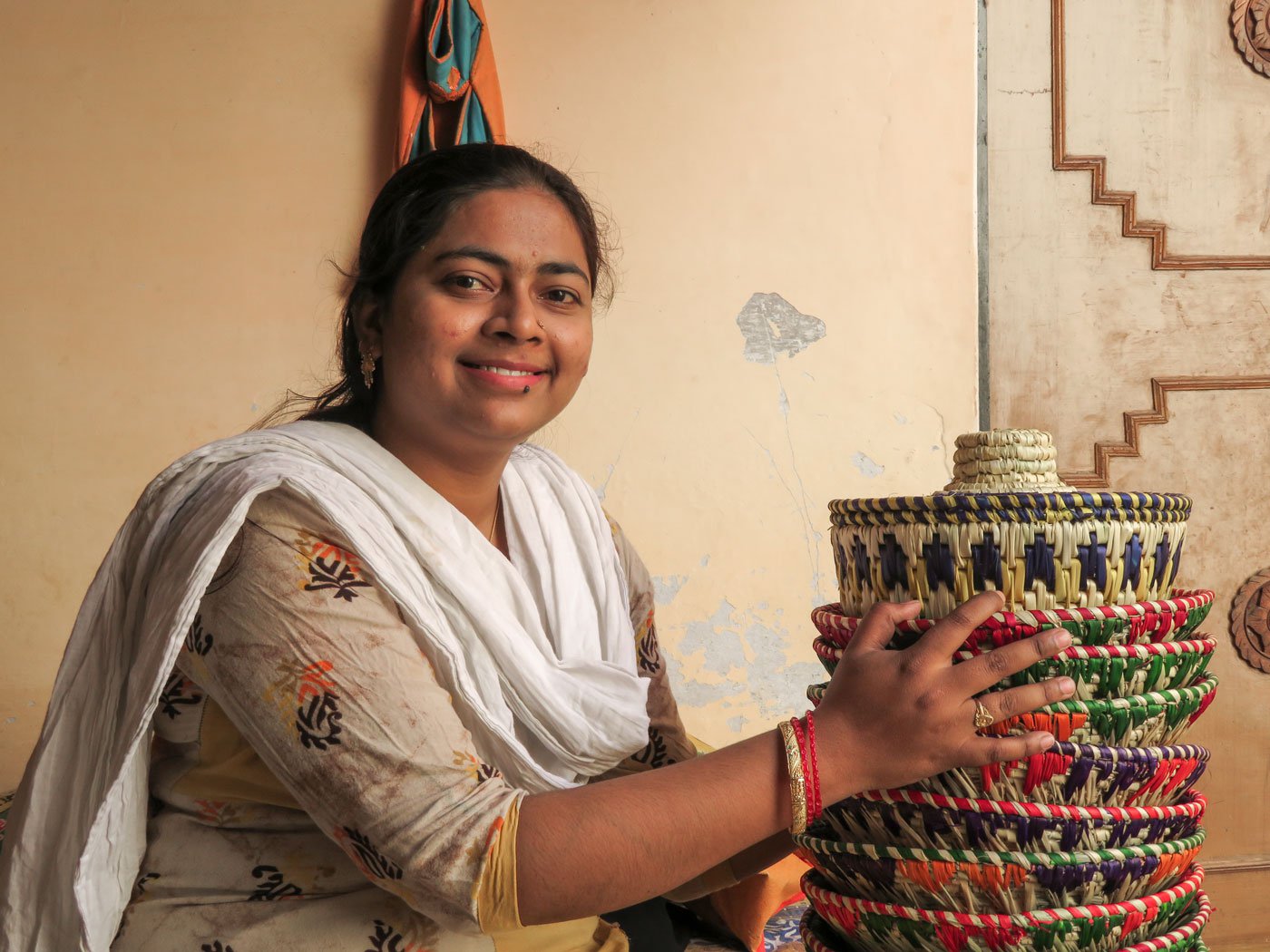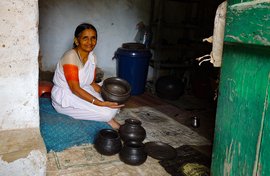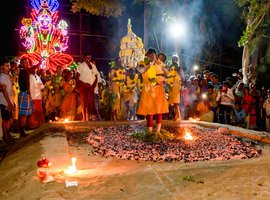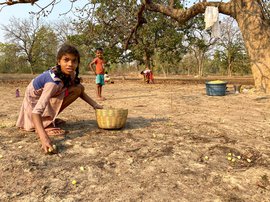Fatima Bibi was never one to let the grass grow under her feet. She preferred grabbing it with both hands. A skilled artisan and craft entrepreneur today, she fashions and sells a variety of household products made from
moonj,
the outer blades of the tapering reed-like
sarpat
grass, which lends its name to a range of products made from it.
“When I was a young girl, I thought my reach would be the kitchen – cooking and managing the home,” she says, laughing at the memory. Deftly slipping off her black niqab , she hangs it on a nail near the front door and enters her home, still talking. “ But when I decided to try something, my family gave me every freedom to go out and make something of my life. I may be a young Muslim woman, but there is nothing I cannot do,” adds the feisty 28-year-old, the silver sequins on her white dupatta twinkling in the afternoon light.
Fatima lives in Mahewa town in Prayagraj (formerly Allahabad) district
of Uttar Pradesh, where the pace of life largely mirrors the unhurried
flow of the Yamuna nearby. “People would ask my father-in-law, ‘A girl from your house is going to go outside and earn money?’ I am not a daughter of the town, so the rules for me are stricter.”
As a girl, Fatima didn’t always know what she would do, but marriage to Mohammed Shakeel brought her to Mahewa and into the home of the experienced moonj artisan, her mother-in-law, Ayesha Begum.
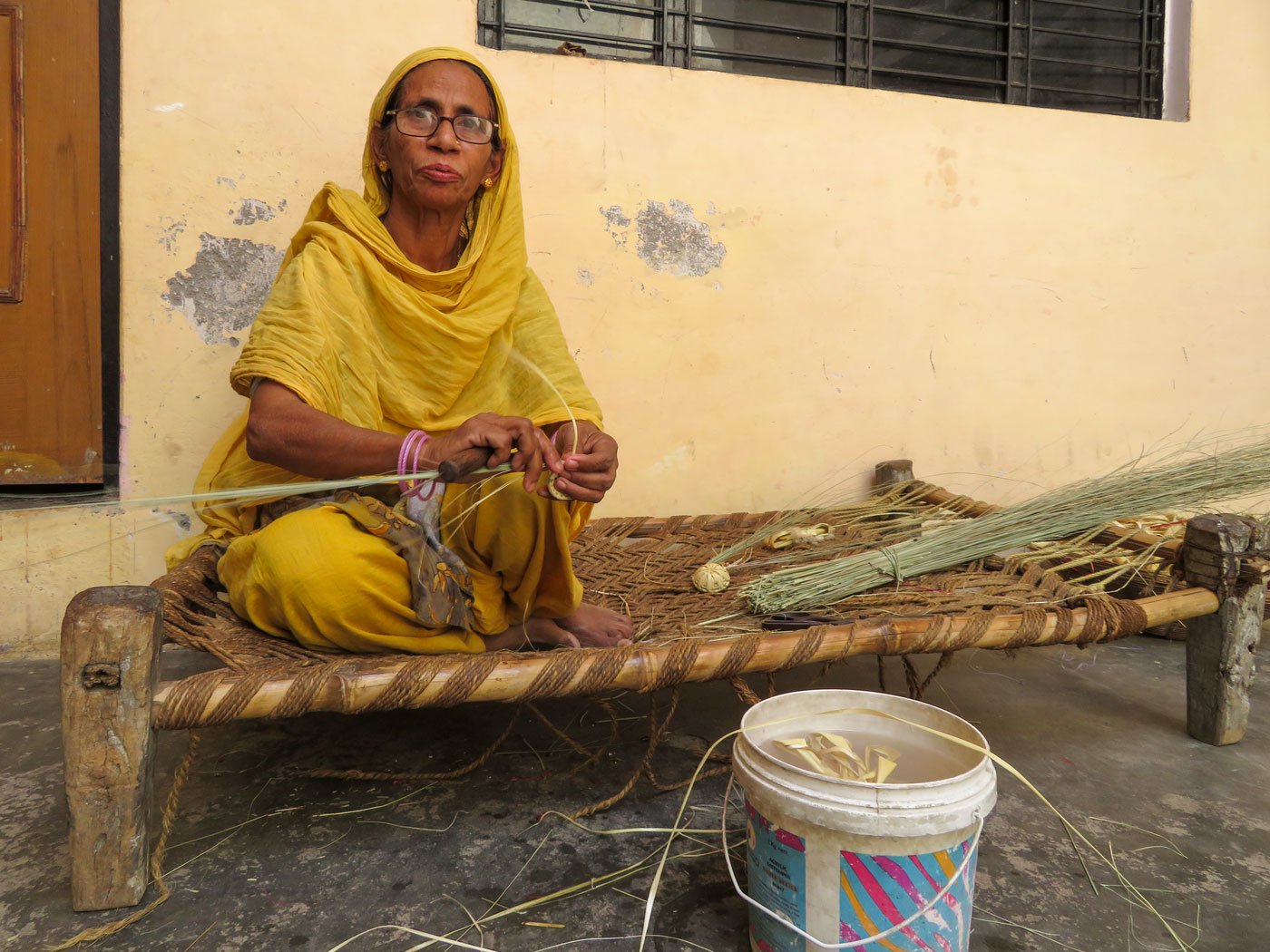
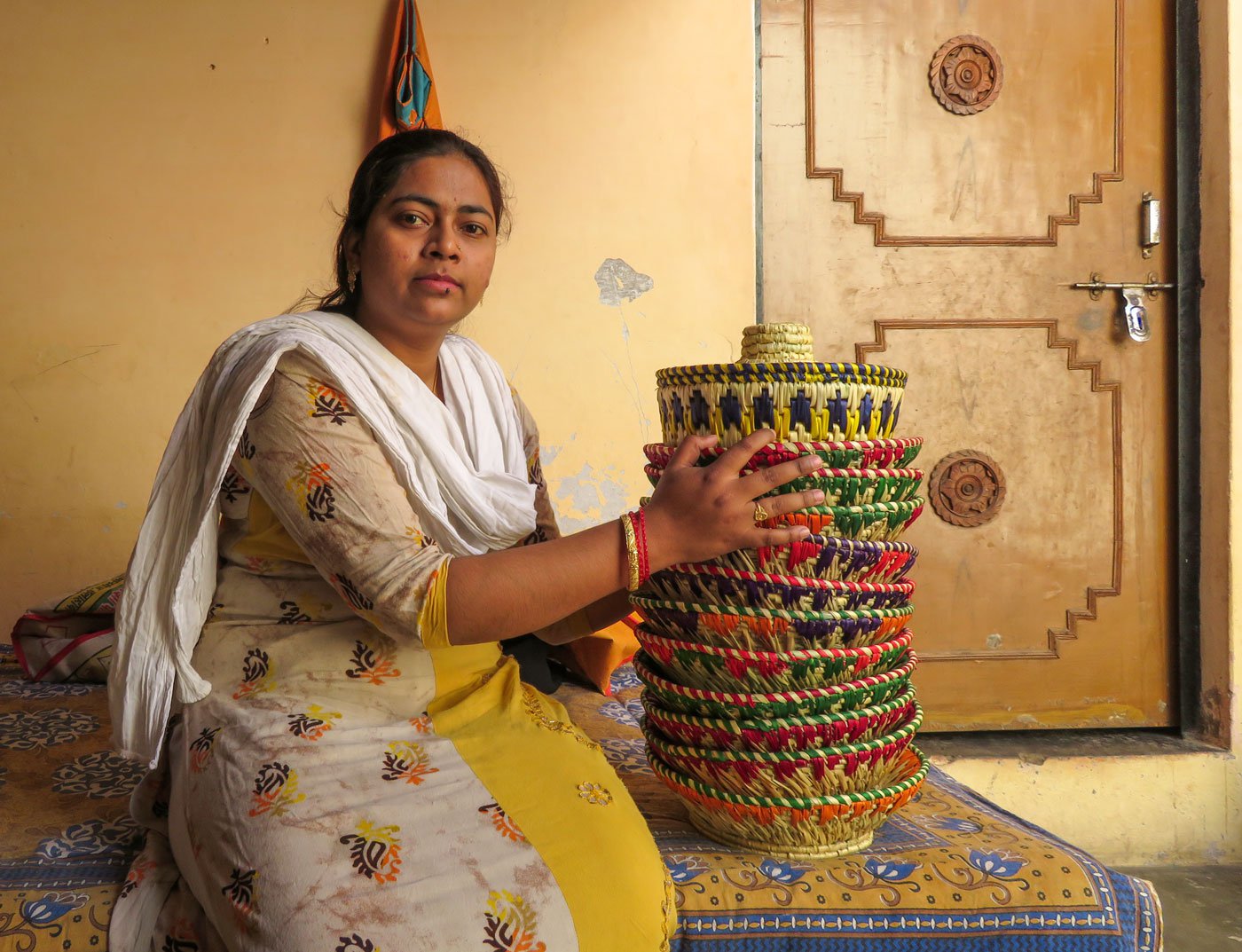
Left: Ayesha Begum weaving the lid of a moonj basket. She crafts a variety of products with the dried grass, like baskets, bins, coasters, jewellery and decorative items. Right: Fatima Bibi, Ayesha's daughter-in-law, with an array of finished baskets, which will be sold in stories and craft exhibitions
The young bride keenly watched how, in Ayesha’s deft hands, moonj was tamed and crafted into an array of products: baskets with and without lids, and of all shapes and sizes; coasters; trays; pen stands; bags; dustbins; and decorative items like tiny swings, tractors and more. The sale of these products brought in a steady income, one that stayed with the women of the house to use as they saw fit.
“I had watched my mother also do it [make moonj products] in our home in Pipirasa,” she says. Within no time, Fatima too picked up the craft. “I was a housewife, working at home, but I had a great desire to do something more. Now [with this work] I can earn around 7,000 rupees a month,” says the mother of nine-year-old Aafiya and five-year-old Aaliyan.
When she is not making moonj artefacts, Fatima is busy promoting the craft in various ways: collecting and marketing moonj products, finding new buyers, organising and conducting training workshops, and trying to shape policy around the craft. She also successfully manages her own women’s self-help group (SHG), which she has named ‘Angel’ – inspired by stories of strong, compassionate women who take other women along. “I enjoy tales and movies where women are happy with other women, not competing,” she explains.
The recognition and respect she receives, including meeting the chief minister of the state, is a big thrill. “Earlier my husband [a motor mechanic] used to wonder about my comings and goings, but now seeing the recognition I get he is proud of me. In the last two years, I have been home barely two days of the week,” she says, sharing her feeling of independence. Meeting her SHG members and buyers, training others and looking after her children takes up all her time.Mahewa’s enterprising women wholeheartedly welcomed the move to promote moonj and grabbed the chance to supplement their income
That still doesn’t stop tongues wagging. “When I attend training meetings where men are present and a photo of the group is taken, people come and tell my mother-in-law, ‘Look at her, being photographed with men!’ But I don’t let that kind of talk stop me,” she says, unwilling to get pulled down by the slings and arrows of narrow societal norms in small-town Uttar Pradesh.
Mahewa Patti Pashchim Uparhar in UP is ranked as a census town (Census 2011) of 6,408 people, but locals still refer to it as ‘Mahewa village’. Located in Karchhana tehsil , it lies a few kilometres from Sangam – the confluence of the Yamuna and Ganga rivers, and an important site of Hindu pilgrimage.
The Yamuna is a vital link that runs through the lives and livelihoods of the people of Mahewa. The craftswomen here also supply small baskets woven out of palm leaves that are filled with flowers and other offerings for pilgrims at Sangam. The men go out to work as mechanics and drivers in Prayagraj city, run small shops nearby or work in eateries.
Interestingly, while the Muslim community accounts for 13 per cent of the population in Prayagraj district (Census 2011), Mahewa’s Muslim population is just over one per cent. Yet, it is primarily and almost solely Muslim women like Fatima and Ayesha who are leading the revival of the craft. “We are training all women, but ultimately, almost all the women who are practising the craft are from one community. Others don’t return to complete the work. Maybe they get busy with other things,” says Fatima.*****
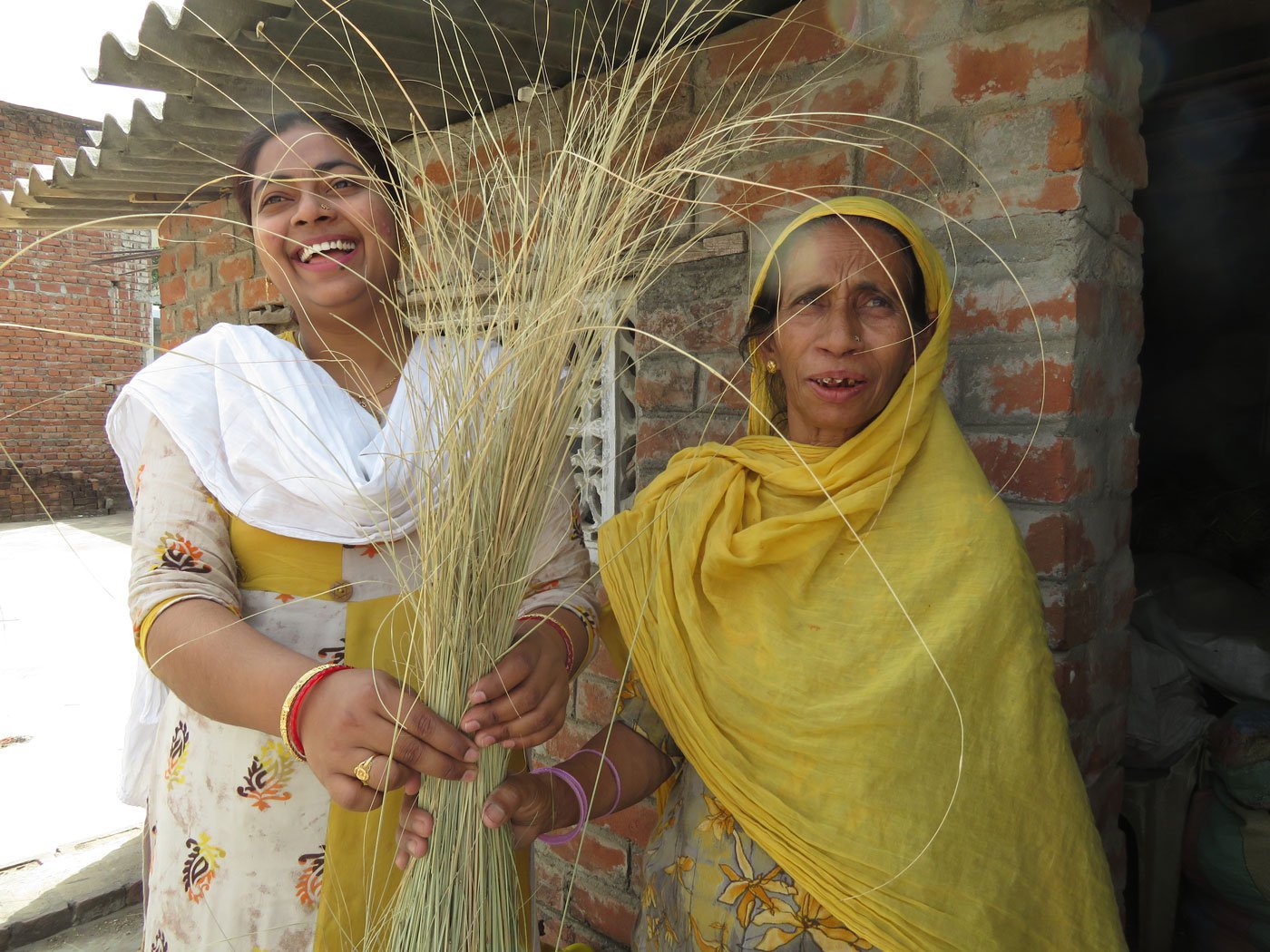
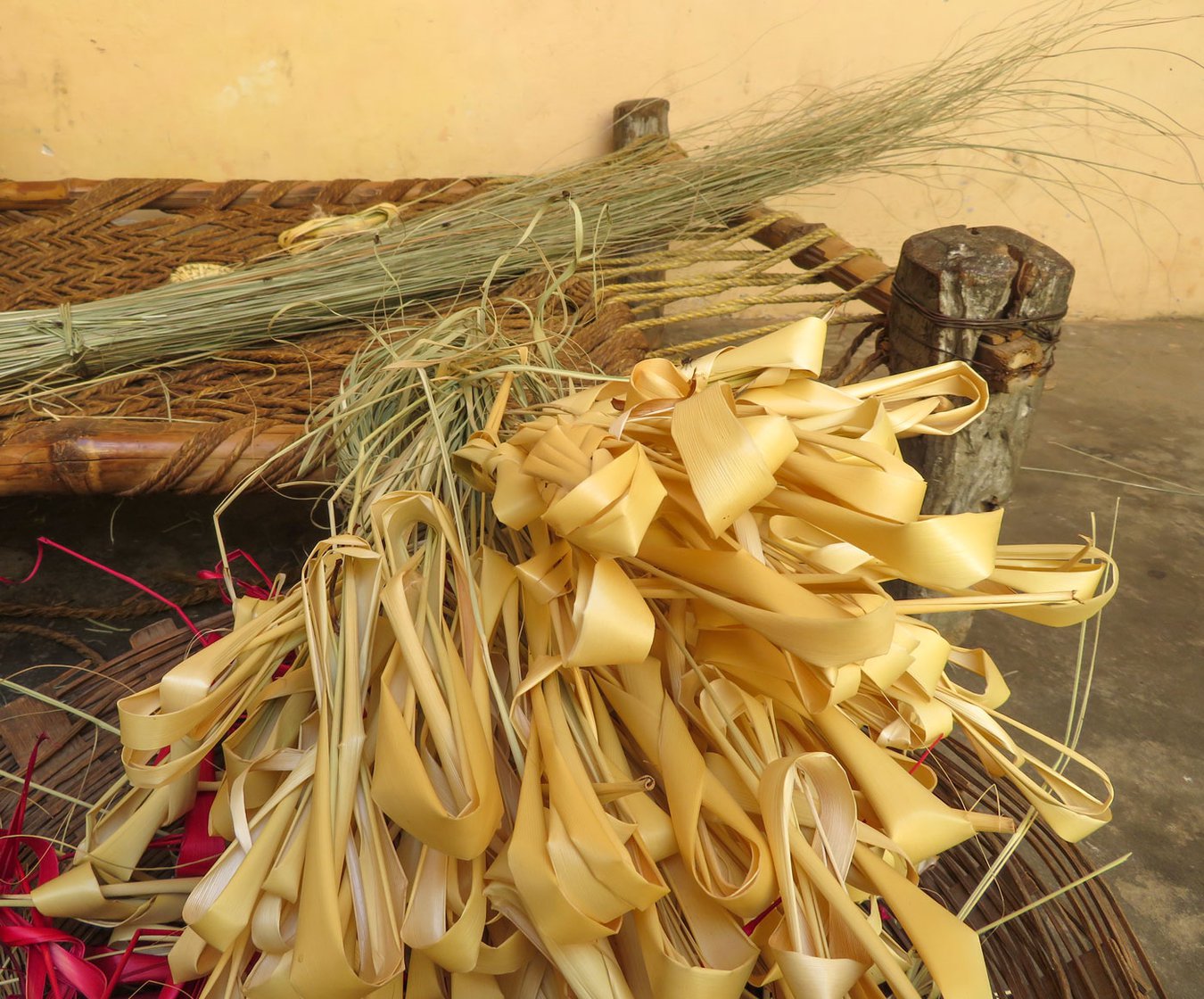
Left: Fatima and Ayesha otuside the room on their terrace, where the dried grass is stored. Right: Freshly cut
moonj
is dried in the sun for a week till it turns cream in colour. It is then tied into bundles along with the dried
kaasa
, a thinner reed used to bind
the moonj
On the terrace of her home in Mahewa, Fatima opens the door to a storeroom piled with wreaths of the precious dried moonj , placed atop discarded household items. “We get moonj only in the cold season [November to February] and we tear the green grass into strips, dry it and store it away here. This is the driest place in the house and there is no wind. Rain and wind alter its colour and turn the grass yellow,” she says.
Yellow grass is not desirable as it is a sign of the grass being too brittle and that it will resist dyeing. A light cream moonj grass allows the artisan to dye it the colour they want. To achieve this, freshly cut moonj must be tied into bundles and carefully dried for a week – in the open, on sunny, windless days.
Fatima’s mother-in-law, Ayesha Begum, has also climbed up to check on the stock. Now in her 50s, master craftsperson Ayesha remembers a time when one could just take a short walk down to the banks of the Yamuna and collect as much grass as one needed. In the last few decades, rampant development and urban spread have shrunk the open riverside land where the wild grass used to flourish unbidden.
“Now, mallahs [boatmen] who traverse the Yamuna’s banks bring us moonj and sell it to us for 300-400 rupees a gatta [one gatta roughly weighs 2-3 kilos],” says Ayesha, as we descend back to the courtyard where she works. With a gatta of moonj , an artisan can expect to make roughly two 12 x 12 inch baskets that are sold for a total of Rs. 1,500; baskets of this size are normally used to grow plants or to store clothes.
The sarpat grass, which reaches heights of between 7 and 12 feet, plays the leading role in moonj craft. Playing a supporting, but important part, is another grass, a thinner reed called kaasa that is used to bind the tougher moonj ; kaasa is barely visible in the final product. Sold in tightly tied handfuls, this grass is available in plenty on the river banks and sells for Rs. 5-10 a bunch.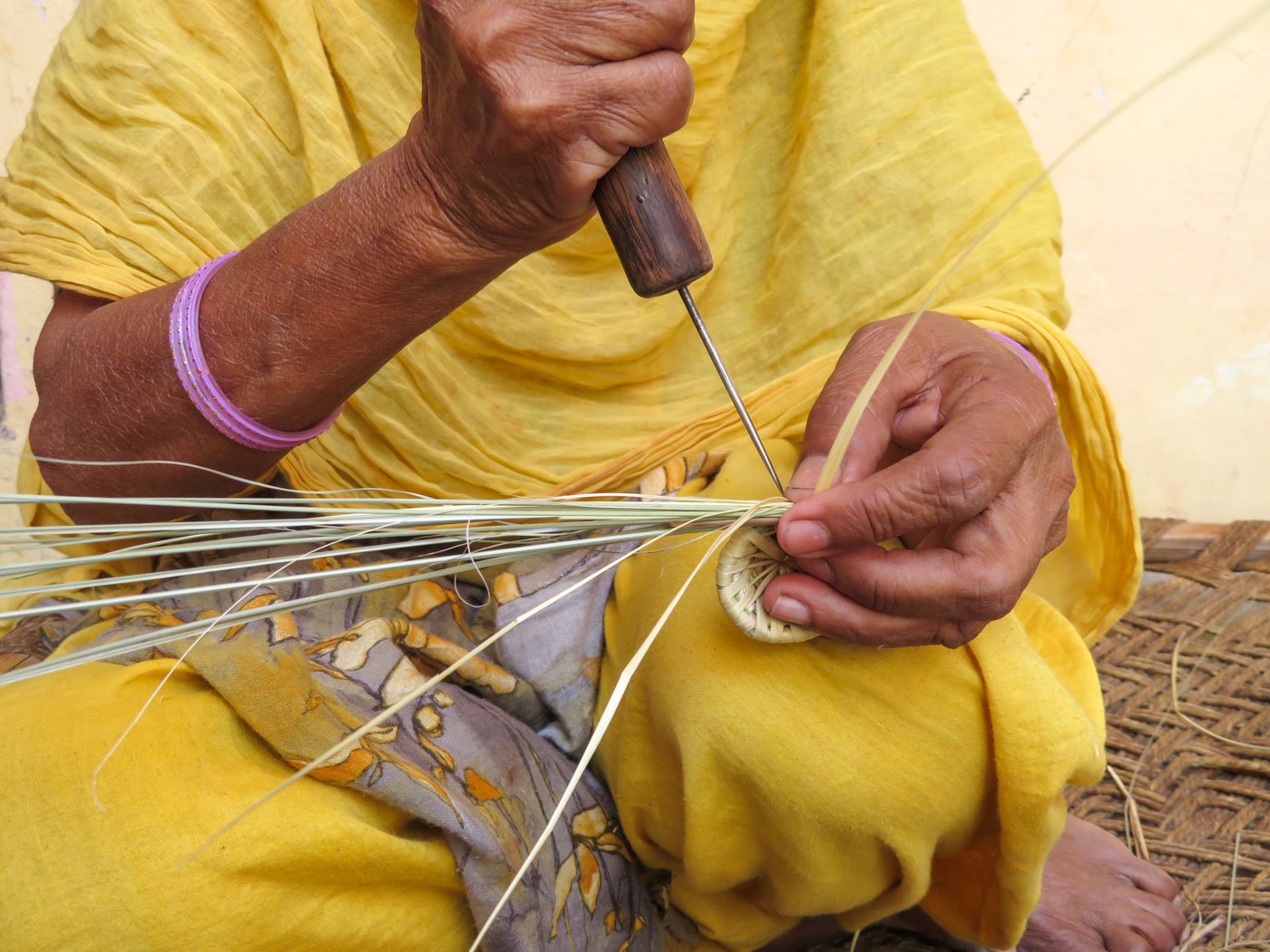
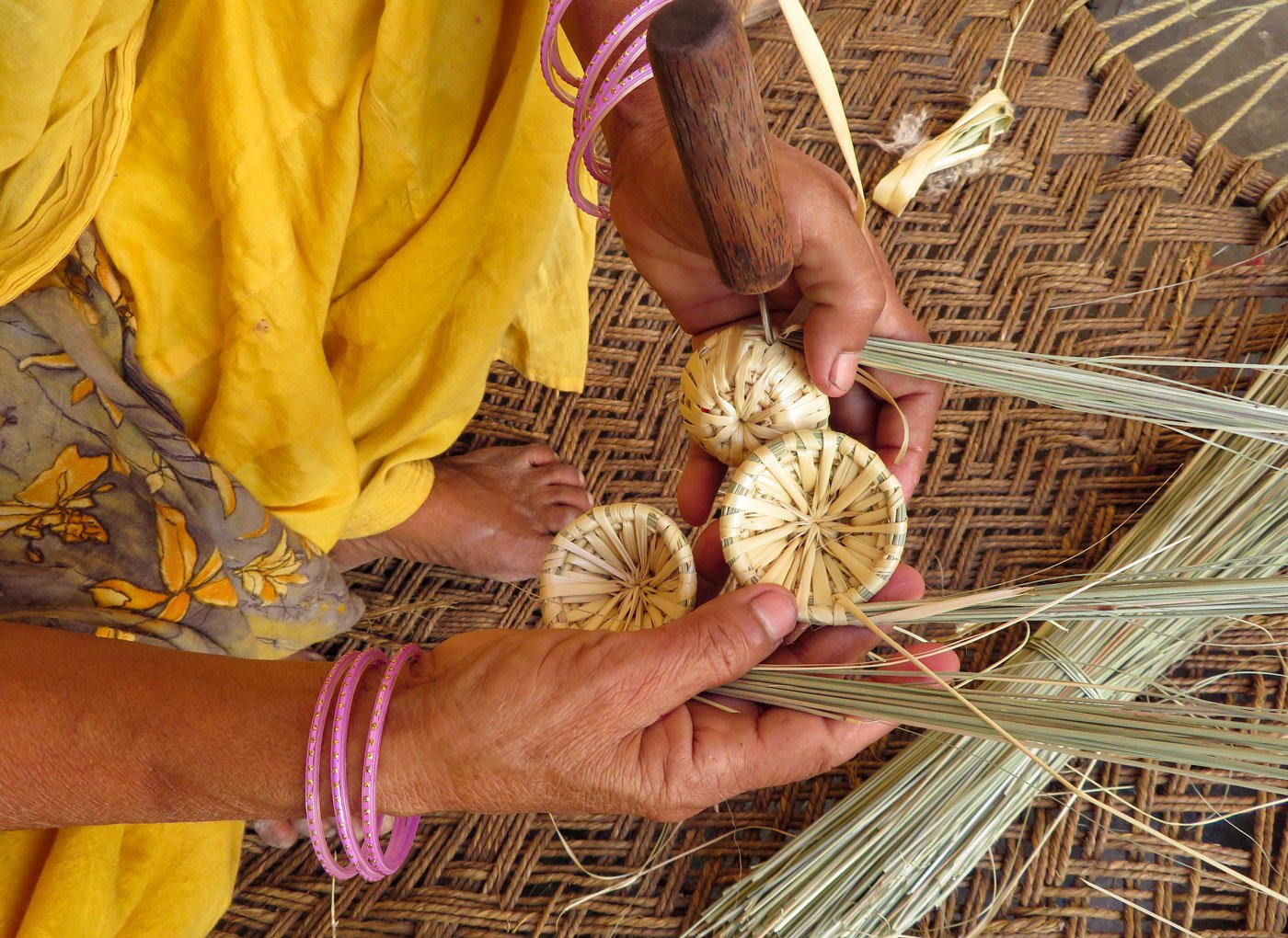
Left: Ayesha Begum weaving a knob with
a
sirahi, a sharp needle
. Right: She coils the thick
moonj
strips around the willowy
kaasa
to create the shape
Seated in the courtyard within their home, Ayesha gets back to work. She’s making a few knobs to go on the lids of baskets. With just a pair of scissors and a sharp needle, she snips, pulls, pushes and tightens the fine blades of grass, occasionally dipping the stubborn ones in a bucket of water to make them more pliable.
“I began [this work] by watching my mother-in-law. The first item I made was a roti ka dabba [box for rotis ] 30 years ago, when I came here as a young bride,” says Ayesha. Once she even made a small swing to hang up the idol of the young Lord Krishna on Janmashthami (a festival that celebrates the day of his birth).
Showing her calloused hands with deep gashes, she says, “Our fingers get cut working with this knife-thin but very strong grass.” Remembering the early days, she adds, “[then] the entire household would pitch in – the women and children making the moonj products and the men selling them in the market. If two to three women in the house worked together, we could earn around 30 rupees a day, enough to run our homes.”
Around a decade ago, demand for moonj had dried up; the number of women practising the craft had fallen and there were few products on sale. Help came in an unexpected development – in 2013, the UP government launched its One District One Product (ODOP) scheme and moonj was chosen as the distinct product of Prayagraj district, its history dating back at least seven decades.
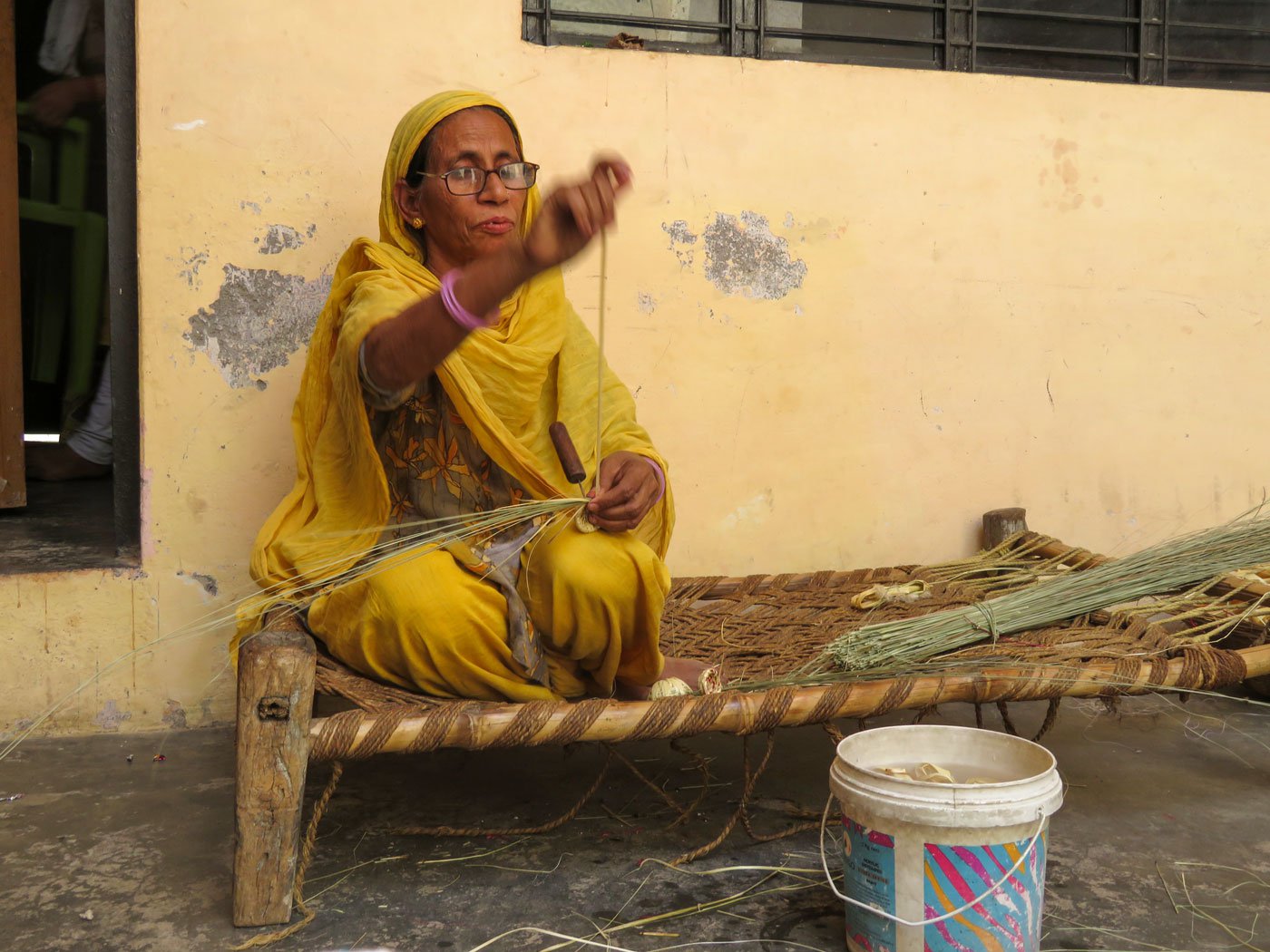

Left: In her 50s, Ayesha Begum is an experienced artisan of
moonj
craft. “I began by watching my mother-in-law. The first item I made was a box for rotis 30 years ago.
” Right: Some of the bins and baskets made by Ayesha recently
“The ODOP status has increased the demand and sale [of moonj products], and so many artisans are returning and new people are also joining [the craft],” says Ajay Chourasia, deputy commissioner for industry, Prayagraj district. He also heads the Zilla Udyog Kendra, the state body through which the ODOP scheme benefits are passed on to the craftswomen. “We are disbursing training and kits to women who come forward to do this and our target is to train 400 women annually,” he adds. The Kendra also supports the craft by organising regular melas and fairs, both statewide and national.
Mahewa’s enterprising women wholeheartedly welcomed the move to promote moonj and grabbed the chance to supplement their income. Fatima says they now get orders on WhatsApp and the work and earnings are distributed equally among the women.
The ODOP scheme has also brought funds to their doorstep. “This scheme gives us access to loans. In my SHG, many have taken 10,000 to 40,000 rupees for starting work,” says Fatima. The scheme offers a 25 per cent subsidy on the total loan amount – that is, 25 per cent of the loan amount is waived. The balance, if paid back within three months, is interest free, and after that it invites an interest of five per cent per annum.
The scheme is expected to help draw women from other places as well. Ayesha’s married daughter, Nasreen, lives in Andawa village in Phulpur tehsil , just 10 kilometres away. “Here [in Andawa] the same grass is only used to thatch roofs before placing tiles to prevent rain water from seeping in,” says the 26-year-old who has a Bachelor’s in Education and Psychology. Having seen the economic potential of moonj work in her home, she is trying to get the craft started here.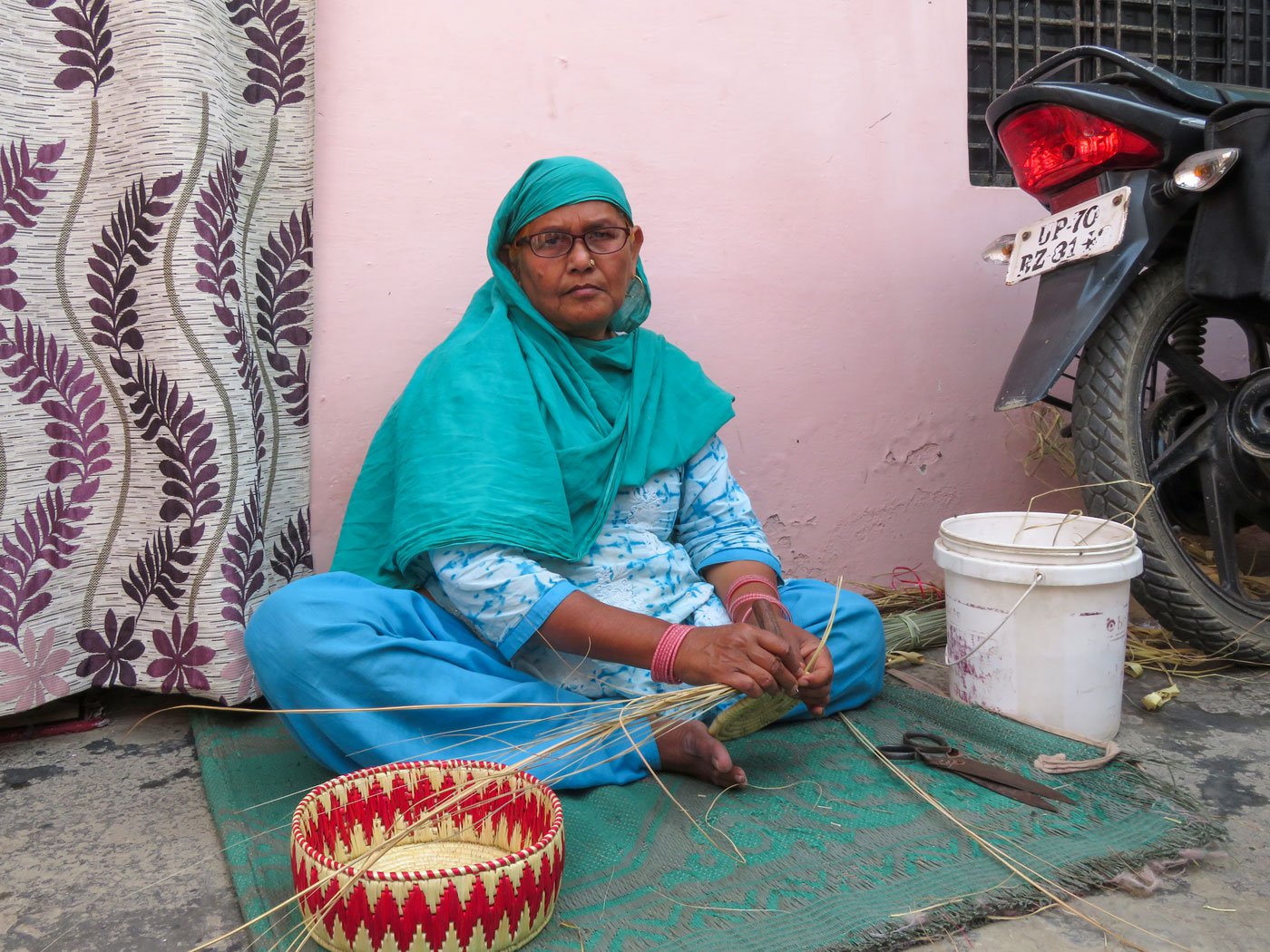
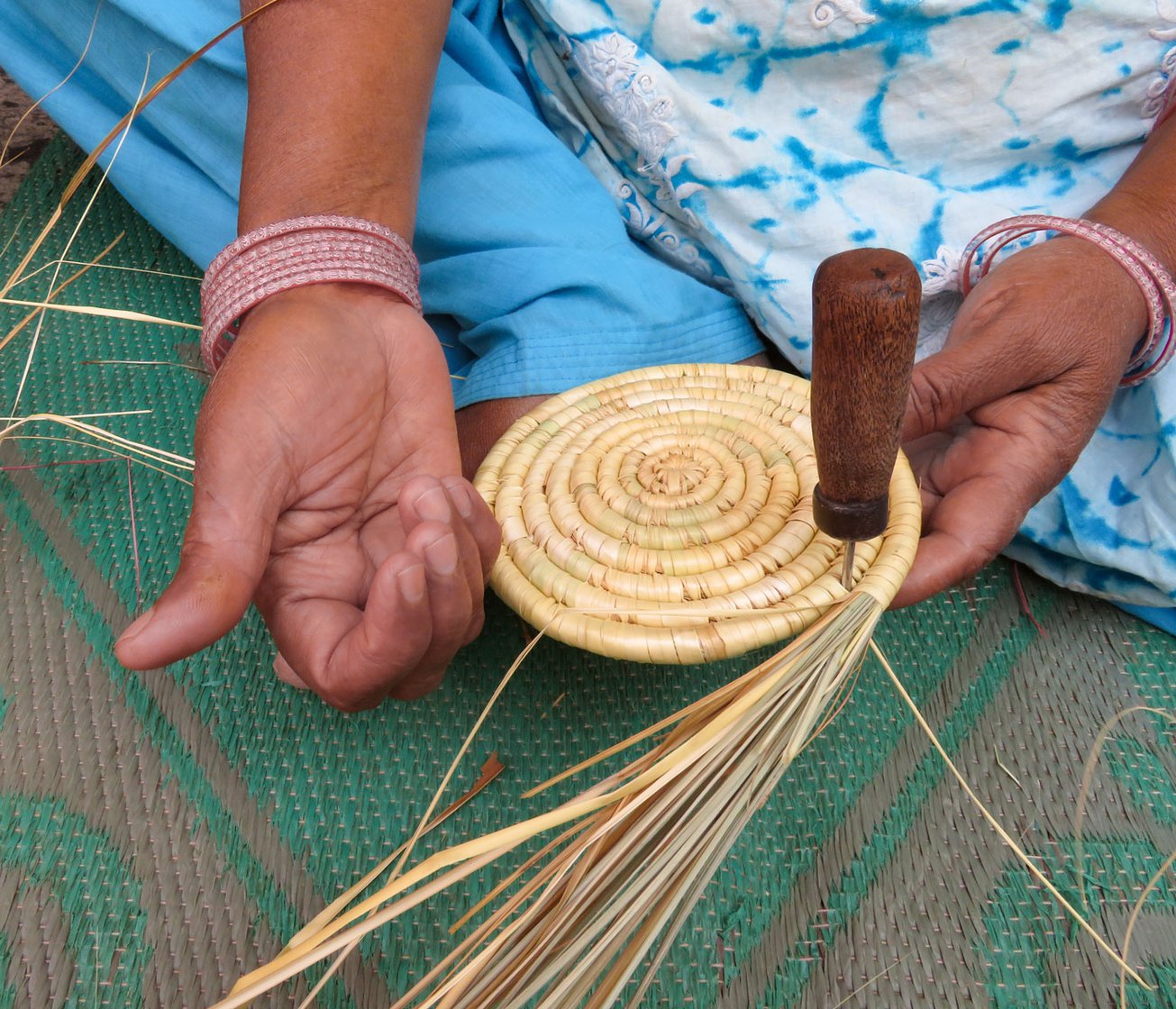
Ayesha Begum and Fatima Bibi's neighbour, whose name is also Ayesha Begum, earns Rs. 150-200 for every moonj product she makes. “Instead of just sitting around, I am earning money and passing my time”
Twenty years ago, a moonj basket to keep rotis would sell for Rs. 20. Today the same basket goes for Rs. 150 or more, and despite inflation, it is seen as a respectable earning. Which is why even at 60, Fatima’s neighbour, whose name is also Ayesha Begum, has a keenness for the craft that hasn't dimmed – unlike her eyes, which do give trouble if she spends too long working. “I can earn around 150-200 rupees per item I make. Instead of just sitting around, I am earning money and passing my time,” she says. She is seated on a floormat in the front courtyard of her home, her back against the wall as her fingers fly in and out, crafting a lid for a basket.
“She will complain of pain in her back after this,” points out her husband, who is listening to her talk. Mohammed Mateen, a retired tea-shop owner, smiles when we ask him if men do this work. “Some men can do it, but I can’t,” he says.
The afternoon is drawing to a close and Fatima’s mother, Aasma Begum, has dropped in at her daughter’s home with finished pieces. Fatima will take them to display and sell at a small exhibition being held at the Circuit House in Prayagraj the next day. Aasma picks up a basket with an elaborately detailed lid to show the work she has done. “A fine coaster for hot dishes can take up to three days to make. You have to do it slowly or the grass tears,” she explains. Artisans use narrower strips of grass to produce a more supple, slim item that also takes longer to make, and demands a higher price.
In her early 50s, Aasma is a well-regarded craftsperson who recently trained 90 women in moonj craft at her home in Pipirasa, about 25 kilometres from Mahewa. Her students’ ages range from 14 to 50 years. “It’s good work. Anyone can learn, earn money and get ahead in life doing this,” she says, adding, “As long as I can I will do this work. I’m very happy with the work my daughter Fatima is doing.”

Left:
Fatima's mother, Aasma Begum (left, in the green
dupatta
),
is an expert craftsperson who trains women in
moonj
craft.
“Anyone can learn, earn money and get ahead in life doing this.” Right: Aasma with one of her creations, a colourful basket with a lid
Aasma studied till Class 4 and was married at the age of 18 to Fatima’s father, a farmer with roughly two acres of land. As a trainer, Aasma earns Rs. 5,000 a month from the Zilla Udyog Kendra, and the girls attending the six-month training sessions are paid Rs. 3,000 a month. “These girls are [otherwise] free and now they are learning something and earning money within the home. Some will use that money to study further,” she says.
For the moonj artisans, next up are plans for a museum and a workshop. “We are waiting for a museum so that visitors can see and appreciate the work we do. It will have the most finely crafted products on show and you will be able to see the process,” says Fatima. The workshop attached to the museum will encourage more women to step forward. Last year, according to Chourasia, the union government allocated Rs. 3 crores for a craft village that will house this museum. “It has started but will take some time to be finished,” he adds.
“In the workshop, some will do only weaving, some will do only colouring work – tasks will be divided. It will be nice, all of us sitting together and working, the community of moonj craftswomen,” says Fatima, her vision for the future tightly woven with the sturdy grass.
The reporter would like to thank Prof. Jahanara and Prof Arif Broadway at the Sam Higginbottam University of Agriculture, Technology and Sciences (SHUATS), Prayagraj, for their generous help with this piece.